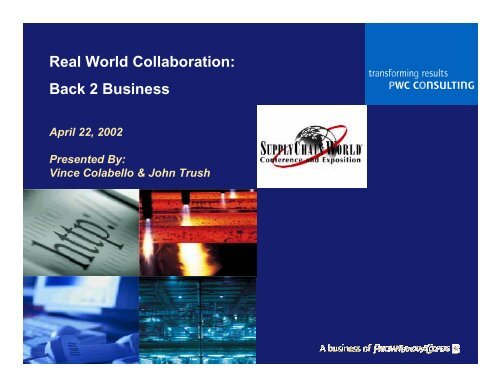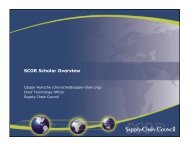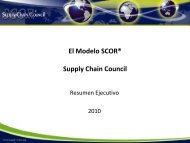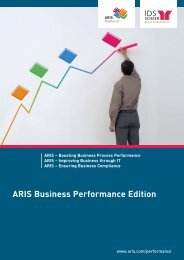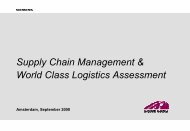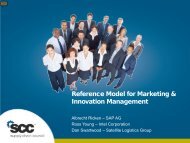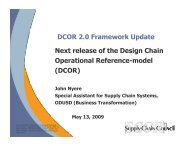Collaborative Partnerships - Supply-Chain.Org
Collaborative Partnerships - Supply-Chain.Org
Collaborative Partnerships - Supply-Chain.Org
Create successful ePaper yourself
Turn your PDF publications into a flip-book with our unique Google optimized e-Paper software.
Real World Collaboration:<br />
Back 2 Business<br />
April 22, 2002<br />
Presented By:<br />
Vince Colabello & John Trush
Global Integration<br />
Globalization of the supply chain will continue as companies seek improved<br />
sourcing options and new market opportunities<br />
Sourcing Opportunity<br />
!Source in local markets<br />
!Meet local content regulations<br />
!Consolidate and leverage global scale<br />
!Develop diversified sources of supply<br />
Market Opportunity<br />
!Build global brands<br />
!Enter emerging markets<br />
!Meet growth goals with<br />
foreign expansion<br />
2<br />
© 2002 PricewaterhouseCoopers, all rights reserved
Many <strong>Org</strong>anizations Have Embraced <strong>Supply</strong><br />
<strong>Chain</strong> Management With Focused<br />
Improvement Efforts To Sustain Success<br />
! Building the equity of products in the marketplace<br />
! Developing alliances with key customers<br />
! Managing a synchronized low cost supply chain<br />
! Collaborating with all <strong>Supply</strong> <strong>Chain</strong> Partners<br />
H<br />
Market<br />
Driven<br />
Leadership<br />
Market<br />
Driven<br />
Leadership<br />
<strong>Supply</strong><br />
Customer<br />
<strong>Chain</strong><br />
Development<br />
Management<br />
Customer<br />
Development<br />
<strong>Supply</strong><br />
<strong>Chain</strong><br />
Management<br />
Market<br />
Share<br />
Growth<br />
Market<br />
Driven<br />
Leadership<br />
Customer<br />
Development<br />
<strong>Supply</strong><br />
<strong>Chain</strong><br />
Management<br />
L<br />
L<br />
Profitability<br />
H<br />
3<br />
© 2002 PricewaterhouseCoopers, all rights reserved
<strong>Supply</strong> <strong>Chain</strong> Management<br />
Why Should I Consider B2B Collaboration<br />
Know the<br />
Customer<br />
Total<br />
Quality<br />
Management<br />
Make To<br />
Demand<br />
Quick<br />
Response<br />
Continuous<br />
Improvement<br />
Demand<br />
Communication<br />
Key<br />
Performance<br />
Indicators<br />
Reduces Costs and Cycle Times . . .<br />
Improves Product Quality . . .<br />
Improves Customer Service . . .<br />
Promotes Continuous Improvement . . .<br />
. . . Increases Competitive Advantages<br />
. . . Increases Strategic Options<br />
4<br />
© 2002 PricewaterhouseCoopers, all rights reserved
Where Are We Today<br />
! Regional / Local Improvement Programs<br />
! Spend Analysis:<br />
– By category of goods or service<br />
– By supplier<br />
! Relationship Assessment and Initiation:<br />
– Conventional / Arm’s Length<br />
– <strong>Collaborative</strong><br />
– Strategic / Alliance<br />
5<br />
© 2002 PricewaterhouseCoopers, all rights reserved
Shift to Strategic Plans for Global<br />
Integration and Collaboration<br />
! Growth Enablers/Competitive Advantage<br />
– Customer Service<br />
– Reduced Cycle Time<br />
– Quality<br />
! New Operating Model<br />
– Based on new competencies<br />
– Meet future customer demands<br />
– Full integration in business<br />
– Produce/link to demand<br />
! Change Management Model<br />
– New measurement system based on value<br />
– Skills development plan<br />
– Project Management<br />
Collaboration,<br />
Private Trading<br />
Networks To<br />
Sustain Savings<br />
And Value<br />
6<br />
© 2002 PricewaterhouseCoopers, all rights reserved
So What’s New<br />
“Strategic” Sourcing Process<br />
Charter Partnership<br />
Team<br />
Design Partnership<br />
Program<br />
Consider<br />
Global Sourcing<br />
Options<br />
Define Sourcing Strategy &<br />
<strong>Supply</strong> Process<br />
Determine Critical<br />
Components/Materials/Services<br />
Install Appropriate Key<br />
Performance Indicators<br />
Consider<br />
New Product<br />
Development<br />
Design & Implement<br />
Manufacturing<br />
Strategy<br />
Excess Capability<br />
Are Current Supplier<br />
Capabilities & Performance<br />
Adequate<br />
Inadequate Capability<br />
Consolidate/Eliminate<br />
Suppliers<br />
Adequate Capability<br />
Select Strategic Partners<br />
Initiate Qualification of of<br />
New Suppliers<br />
Jointly Establish Targets for<br />
Improvements<br />
Develop & Implement Action<br />
Plans<br />
Yes<br />
No<br />
Continue<br />
Relationship<br />
Monitor Progress<br />
Can New Capabilities<br />
Support Requirements<br />
No<br />
Yes<br />
7<br />
© 2002 PricewaterhouseCoopers, all rights reserved
<strong>Collaborative</strong> <strong>Partnerships</strong><br />
The <strong>Collaborative</strong> Vision<br />
! Recognize the importance of long-term relationships with select partners for the mutual<br />
success<br />
! Understand each other’s processes, needs and capabilities<br />
! Commit to the continuous improvement of product development, manufacturing,<br />
distribution, quality, service and communications<br />
! Provide products that consistently meet or exceed mutually agreed-upon requirements<br />
! Resolve conflicts at the lowest levels of operation with the quickest impact<br />
! Operate as a cohesive team with a focus on achieving “win-win” resolutions<br />
8<br />
© 2002 PricewaterhouseCoopers, all rights reserved
<strong>Collaborative</strong> <strong>Partnerships</strong><br />
The partnership process shifts the way we view our specific relationships<br />
Arms Length Relationship<br />
! Price Emphasis<br />
! Many Alternatives<br />
! Functional Silos<br />
! Short-Term Buying<br />
! High Levels of Safety Stock<br />
! Expediting Due to Problems<br />
! Historical Information<br />
! Short Shipments<br />
! Inefficient Use of Capacity<br />
<strong>Collaborative</strong> Partnership<br />
! Lowest Total Systems Cost<br />
! Few “Alliance” Participants<br />
! Cross-Functional Teams<br />
! Long-Term Commitments<br />
! Compressed Cycle Times & Reduced<br />
Inventories<br />
! Anticipating Future Capabilities<br />
! “Real-Time” Information<br />
! Reliability and Customer Service Focus<br />
! Run Strategy & Synchronization<br />
9<br />
© 2002 PricewaterhouseCoopers, all rights reserved
<strong>Collaborative</strong> <strong>Partnerships</strong><br />
Open sharing of information is critical to the partnership process<br />
Traditional Structure<br />
Partnership Structure<br />
Accounting<br />
Accounting<br />
Accounting<br />
Accounting<br />
Information<br />
Systems<br />
Sales Buying Information<br />
Systems<br />
Information<br />
Systems<br />
Information<br />
Systems<br />
Operations<br />
Operations<br />
Operations<br />
Operations<br />
Sales<br />
Buying<br />
Supplier Customer Supplier Customer<br />
The expansion of direct links is necessary to improve communication.<br />
10<br />
© 2002 PricewaterhouseCoopers, all rights reserved
<strong>Collaborative</strong> <strong>Partnerships</strong><br />
It is important to understand the current and historic relationship to<br />
accurately assess and develop <strong>Collaborative</strong> <strong>Partnerships</strong>.<br />
! Financial stability of participants<br />
! Percentage of business (who relies on whom to be successful)<br />
! Unique technologies/expertise<br />
! Contract conditions/commitments<br />
! Ability to manage competitive pressures and changing market conditions<br />
! Capacity constraints (who has extra or needs more)<br />
! History with supplier (willingness to cooperate in the past)<br />
! Company culture<br />
! Expansion/consolidation plans<br />
Each relationship is evaluated individually.<br />
11<br />
© 2002 PricewaterhouseCoopers, all rights reserved
<strong>Collaborative</strong> <strong>Partnerships</strong><br />
When developing partnerships, it is necessary to decide which suppliers<br />
will make the best partners.<br />
The Supplier Relationship Continuum<br />
Arms Length<br />
<strong>Collaborative</strong><br />
Strategic<br />
Class III<br />
50 - 60%<br />
Class II<br />
35 - 40%<br />
Class I<br />
5 - 10%<br />
12<br />
© 2002 PricewaterhouseCoopers, all rights reserved
Model of Price/Cost<br />
Development vs. Relationship<br />
Characteristics Supplier Advantage Customer Advantage<br />
RELATIONSHIP<br />
Arms Length <strong>Collaborative</strong> Strategic<br />
Supplier Price Regular Inflationary Decreases Decreasing Further Decreases<br />
Increases<br />
Supplier Costs Stable Stable Decreasing Decrease<br />
(Within Range) (Within Range) (By Design)<br />
Supplier Margin Increasing Decreasing Relatively Stable Stable<br />
Relationship Adversarial Adversarial Cooperative Integrated<br />
Cost Structure Unknown Challenged But Focused on Specific Transparent<br />
Largely Unknown<br />
Cost Drivers<br />
Pricing Mechanism Competitive Threat Competitive Threat Cost Principal Targeted – Expect<br />
15% to 40%<br />
Improvements<br />
The goal is to select the appropriate Collaboration Partners.<br />
13<br />
© 2002 PricewaterhouseCoopers, all rights reserved
Strategic Supplier <strong>Partnerships</strong><br />
Factors that would influence a company to enter a strategic partnership:<br />
! Critical material or service - strategic importance to the business<br />
! Creates a competitive advantage<br />
! Leading edge technology<br />
! Willingness to jointly develop<br />
! High dollar/volume items<br />
! Potential for significant rewards<br />
! Strategic defense<br />
! New product introduction<br />
! Expanded resource base<br />
! Market volatility - availability of materials<br />
A partnership needs to be flexible to meet business shifts, new<br />
requirements and other changes.<br />
14<br />
© 2002 PricewaterhouseCoopers, all rights reserved
<strong>Collaborative</strong> <strong>Partnerships</strong><br />
What do Most Suppliers Want<br />
! “Just tell me what you really want to the best of your knowledge”<br />
– Short-term<br />
– Long-term<br />
– Specify variation and certainty of projections<br />
! More business volume<br />
! The “right of first refusal” for new products<br />
! Longer-term commitments<br />
! A well-defined formal relationship<br />
Each supplier has specific individual needs.<br />
15<br />
© 2002 PricewaterhouseCoopers, all rights reserved
<strong>Collaborative</strong> <strong>Partnerships</strong><br />
Regardless of the approach selected,<strong>Collaborative</strong> Partners will have many<br />
shared benefits<br />
! Improved capacity utilization<br />
! Increased process reliability<br />
! Reduced inventories<br />
! Reduced cycle times<br />
! Increased flexibility<br />
! Increased customer service<br />
! Shared innovation/technology<br />
! Reduced total system costs<br />
Implementation of identified opportunities will create new strategic options.<br />
16<br />
© 2002 PricewaterhouseCoopers, all rights reserved
<strong>Collaborative</strong> <strong>Partnerships</strong><br />
“Best” suppliers can clearly distinguish themselves from other<br />
suppliers by using Collaboration as a:<br />
! Growth Enabler<br />
– Selection of strategic customers (that meet your criteria)<br />
– Focus on long term success through growth<br />
– Institutionalize linkages with key customer organizations<br />
– Realize global opportunities to partner (NAFTA, ECU, etc.)<br />
! Competitive Advantage<br />
– Understand the new operating model<br />
– Put competencies in place<br />
– Recognized as the supplier of choice<br />
– The “Right of First Refusal” on future products<br />
! Change Management Model for Flexibility<br />
– New measurement system based on value<br />
– Continuous process to identify and implement opportunities<br />
– Skills development plan<br />
Focused action is needed to capitalize on this window of opportunity<br />
17<br />
© 2002 PricewaterhouseCoopers, all rights reserved
For One Company, the Anticipated<br />
Benefits of Collaboration Include:<br />
! Developing a common approach to identifying and documenting reliability and<br />
synchronization.<br />
! Eliminating process inefficiencies that lead to increased costs to either xxxx or their<br />
suppliers.<br />
! Identifying opportunities for suppliers to reduce costs and free up additional capacity.<br />
! Identifying opportunities for xxxx to reduce combined supply inventory and improve<br />
cash management.<br />
! Developing a process for jointly improving capability and sharing benefits.<br />
! Optimizing specification requirements to reflect supplier capabilities.<br />
! Involving supplier at the early stages of new product development.<br />
! Accelerating response and correction of problems and issues.<br />
! Increasing yield and reducing downtime due to shared information and data.<br />
18<br />
© 2002 PricewaterhouseCoopers, all rights reserved
Supplier Stakeholders Impact Survey<br />
Impacts Questionnaire<br />
1. Are you a member of any E-Hubs<br />
– If you are not involved with any E-Hubs, what are your reasons for not participating<br />
– If yes, how many and to what extent<br />
– To what level are you involved in content management, catalogues, transaction<br />
processing<br />
2. What is the cost to you for participating in an E-Hub<br />
– Initial hook up<br />
– Ongoing (basis)<br />
3. Is your level of business through E-Hubs significant<br />
– Number of customers<br />
– % of Sales<br />
19<br />
© 2002 PricewaterhouseCoopers, all rights reserved
Supplier Stakeholders Impact Survey<br />
Impacts Questionnaire<br />
4. Do you anticipate that Collaboration through E-Hubs and Supplier Relationship<br />
Management ( SRM ) will increase or decrease<br />
5. To what extent is the use of e-Commerce part of your business strategy,<br />
business plan and budget<br />
6. What is the level of effort/readiness needed to support e Commerce in your<br />
organization<br />
– Technology<br />
– Process<br />
– Skill sets<br />
7. What factors will most influence the expansion rate of E-Hubs in your industry<br />
20<br />
© 2002 PricewaterhouseCoopers, all rights reserved
Supplier Stakeholders Impact Survey<br />
Impacts Questionnaire<br />
8. How/what should Customers developing E-Hubs do to benefit suppliers<br />
– Longer term commitments<br />
– Defined formal relationship<br />
– Cost elimination agreements<br />
– Faster more accurate payments<br />
– Value added Services<br />
– Increased volume with Current customer base<br />
– Participation in New products<br />
– Other<br />
9. What are the advantages of being a member<br />
10. What are the major disadvantages to a supplier<br />
11. How can these disadvantages best be minimized or eliminated<br />
21<br />
© 2002 PricewaterhouseCoopers, all rights reserved
Supplier Stakeholders Impact Survey<br />
! Surveyed a cross section of suppliers about Collaboration and participation in<br />
an E-Hub:<br />
– Level of understanding<br />
– Perceived value<br />
– Readiness for collaboration<br />
! We contacted 50+ companies and received responses as follows:<br />
– 7 companies that supply direct materials<br />
– 7 companies that supply services<br />
– 3 companies that supply indirect materials<br />
– 3 companies that supplied multiple material types and are consolidated above<br />
22<br />
© 2002 PricewaterhouseCoopers, all rights reserved
Supplier Stakeholder Impact Survey<br />
Impacts Survey<br />
! All the suppliers' had a reasonable understanding of the benefits and challenges of<br />
Collaboration with a Customer through an E-Hub and the majority of the response were<br />
positive and optimistic. As anticipated there were a variety of opinions regarding the<br />
perceived value and benefits to the suppliers, ranging from negative to extremely<br />
positive. The suppliers expressed varying levels of readiness.<br />
! The responses from suppliers were similar to responses that we have received when<br />
surveying suppliers of exchanges and suppliers with buying consortiums. There was a<br />
consistent theme within the following three categories:<br />
– Direct Materials<br />
– Services<br />
– Indirect Materials<br />
23<br />
© 2002 PricewaterhouseCoopers, all rights reserved
Supplier Stakeholders Impact Survey<br />
Impacts Survey<br />
Direct material suppliers<br />
! The response in this category was mixed. With the exception Chemicals and High<br />
Tech suppliers, these suppliers did not perceive significant benefits and were only<br />
moderately receptive to <strong>Collaborative</strong> E-Hubs.<br />
– Not currently involved with significant Collaboration<br />
– Not major focus in their Business plans<br />
– Would reluctantly participate only if required by their customers<br />
– Did not appreciate the value of collaborative planning<br />
– Preferred EDI and point to point communications<br />
– Perceived significant increases in the pressure on profits and margin reductions<br />
– Not actively preparing for changes to adopt Technology, Process or Skill sets<br />
24<br />
© 2002 PricewaterhouseCoopers, all rights reserved
Supplier Stakeholders Impact Survey<br />
Impacts Survey<br />
Services<br />
! These companies were involved in providing services such as consulting, staffing,<br />
travel, and technical support. While there was some variation in their responses, as a<br />
group, these suppliers were positive about Collaboration and in most cases in the early<br />
implementation phase but actively planning and moving to significant expansion in their<br />
B2B business activities.<br />
– E-Business is a priority focus in their Business plan<br />
– Actively involved in promoting e-business with customers and suppliers<br />
– Anticipate major benefits<br />
– Most common concerns are:<br />
» Having to work through technology requirements<br />
» Less personal relationships<br />
» In early states of planning for changes in technology, process and skill sets<br />
25<br />
© 2002 PricewaterhouseCoopers, all rights reserved
Supplier Stakeholders Impact Survey<br />
Impacts Survey<br />
Indirect Materials<br />
! As a group these suppliers were the leading companies in adopting and implementing<br />
B2B and are the most advanced in Collaboration/SRM understanding and readiness.<br />
They had already experienced proven results, which were a significant contributor to<br />
their revenue.<br />
– Leaders in e-Procurement<br />
– Significant portion of their business is currently conducted via e-procurement<br />
– Currently obtaining major benefits such as increased sales<br />
– Most common concern was that an E-Hub would not provide the same quality of<br />
information as their current systems.<br />
26<br />
© 2002 PricewaterhouseCoopers, all rights reserved
Supplier Stakeholders Impact Survey<br />
Impacts Survey<br />
Summary of Supplier Benefits<br />
! Based on prior Supplier surveys the top five desires of Suppliers are:<br />
1. An increase in the amount of business<br />
2. A better knowledge and understanding of the certainty and variability of the<br />
information provided by customers<br />
3. The right of first refusal of new business<br />
4. Long term commitments (except in the case of volatile commodities)<br />
5. Defined formal partnerships<br />
27<br />
© 2002 PricewaterhouseCoopers, all rights reserved
Supplier Stakeholders Impact Survey<br />
Impacts Survey Summary<br />
No. Of<br />
Companies<br />
Category<br />
Benefit<br />
to Supplier<br />
Readiness<br />
1<br />
2<br />
3<br />
4<br />
5<br />
6<br />
7<br />
8<br />
9<br />
10<br />
11<br />
12<br />
13<br />
14<br />
15<br />
16<br />
17<br />
Direct<br />
Direct<br />
Direct<br />
Direct<br />
Direct<br />
Direct<br />
Direct<br />
Indirect<br />
Indirect<br />
Indirect<br />
Service<br />
Service<br />
Service<br />
Service<br />
Service<br />
Service<br />
Service<br />
H<br />
M<br />
M<br />
M<br />
L<br />
L<br />
L<br />
H<br />
H<br />
H<br />
H<br />
H<br />
H<br />
H<br />
M<br />
M<br />
M<br />
H<br />
M<br />
M<br />
L<br />
L<br />
L<br />
L<br />
H<br />
H<br />
H<br />
H<br />
M<br />
H<br />
M<br />
M<br />
H<br />
L<br />
Conclusion: Suppliers perceive value through Collaboration, however, supplier<br />
readiness assessments and education process will be required<br />
28<br />
© 2002 PricewaterhouseCoopers, all rights reserved
The <strong>Collaborative</strong> Landscape<br />
e-Fulfillment<br />
<strong>Collaborative</strong> supply<br />
chain/production planning<br />
Retail<br />
Customer Care<br />
(demand data, customer data visibility)<br />
e-Procurement<br />
(on-line supply catalogue, on-line selection,<br />
e-auction/marketplace)<br />
B2B<br />
Procurement<br />
Manufacturing<br />
Company<br />
Internal<br />
Infrastructure<br />
Marketing<br />
Sales<br />
B2C<br />
On-line order management<br />
(real-time ATP, e-shipment notification, order tracking)<br />
Logistics<br />
Customer Service<br />
<strong>Collaborative</strong> Product<br />
Commerce<br />
(<strong>Collaborative</strong> design, product data management)<br />
Distribution<br />
e-Logistics<br />
(<strong>Collaborative</strong> planning, supply chain management,<br />
capacity and cost optimization)<br />
Vendor (co-) managed<br />
inventory<br />
29<br />
© 2002 PricewaterhouseCoopers, all rights reserved
Horizontal Services<br />
Collaboration Models<br />
e-Hub Trade Exchanges Marketplace<br />
Indirect<br />
Suppliers<br />
Companies<br />
Company A<br />
eMarket<br />
Intermediary<br />
Company<br />
A<br />
Company<br />
B<br />
Company<br />
A<br />
Company<br />
C<br />
Company A<br />
Company<br />
B<br />
Company<br />
C<br />
Direct<br />
Suppliers<br />
Model Type<br />
Company<br />
Centric<br />
Industry<br />
Vertical Indirect<br />
Industry Vertical<br />
Direct and<br />
Indirect<br />
Vertical<br />
Exchange<br />
Meta-Market<br />
Characteristics<br />
All suppliers (or<br />
customers) to<br />
Company A are<br />
linked with<br />
Company A and,<br />
where applicable,<br />
each other<br />
Groups of buyers<br />
with common<br />
interests align to<br />
gain leverage<br />
Community<br />
forms around<br />
common exchange<br />
of direct and<br />
indirect goods<br />
“Platform” built for<br />
eBusiness within a<br />
vertical market<br />
enhancing processes<br />
across the value chain<br />
Multiple companies<br />
integrate processing<br />
leveraging buying,<br />
selling, and crossindustry<br />
horizontal<br />
services<br />
30<br />
© 2002 PricewaterhouseCoopers, all rights reserved
The Three Dimensions of <strong>Collaborative</strong><br />
Evolution<br />
Integration<br />
Browser-to-browser ERP-to-ERP APS-to-APS<br />
Buyer<br />
Richness<br />
Market<br />
Seller<br />
!Supplier and Buyer ERPs not linked<br />
!No information visibility<br />
!<strong>Supply</strong> chain efficiencies minimal<br />
Indirect Materials Procurement<br />
Buyer<br />
Market<br />
Seller<br />
!Many supply chain efficiencies<br />
!Some information visibility<br />
Indirect Materials + Value Added<br />
Services (Logistics, Credit/Finance,<br />
Insurance etc.)<br />
Buyer<br />
Seller<br />
Market<br />
!Machine-to-machine integration<br />
!<strong>Supply</strong> chain optimization<br />
!Complete information visibility<br />
Indirect Materials + Expanded<br />
Breadth of Value Added Services +<br />
Direct Materials Procurement<br />
!Scope limited to MRO goods<br />
!No direct materials or value-added services<br />
Reach<br />
Fragmented Company-Centric/Vertical<br />
Procurement Alliances<br />
!MRO goods and some value added services<br />
Industry Vertical<br />
Procurement Community<br />
!Complete suite of materials and services<br />
Pan-industry metamarket<br />
HR<br />
Benefits<br />
Logistics<br />
MRO<br />
Marketing<br />
Oil & Gas<br />
Auto<br />
Telecom<br />
High Tech<br />
!Single e-Hub or multiple anchor-led E-Markets<br />
within an industry sector<br />
!Consolidation of E-Markets within an industry<br />
sector into one procurement community<br />
!Meshing of several industry procurement<br />
communities to leverage cross-industry efficiencies<br />
31<br />
© 2002 PricewaterhouseCoopers, all rights reserved
<strong>Supply</strong> <strong>Chain</strong> Optimization<br />
Optimizing an individual business or optimizing a network of businesses for<br />
competitive advantage<br />
Private Trading Networks (e-Hub)<br />
VALUE CHAIN OPTIMIZATION<br />
Procure<br />
Produce<br />
Products<br />
Manage<br />
Logistics<br />
Forecast<br />
Demand<br />
! Independently manages hundreds of supplier<br />
relationships<br />
! Builds upon its own market power and<br />
infrastructure<br />
! Customer and market access limited by front<br />
office organizational capacity<br />
! Optimizes its own supply chain<br />
! Procurement through automated processes<br />
E-Markets and Trade Exchanges<br />
NETWORK OPTIMIZATION<br />
Company<br />
A<br />
Company<br />
B<br />
Company<br />
D<br />
Company Company<br />
G E<br />
Company C<br />
F<br />
Company<br />
! Communities of similar businesses jointly<br />
manage suppliers<br />
! Leverage the market power and<br />
infrastructure of many<br />
! Accesses customers through established<br />
networks<br />
! Optimize a market supply chain vs. an<br />
individual supply chain<br />
! Automated end-to-end e-Procurement<br />
solutions (requisition to payment)<br />
32<br />
© 2002 PricewaterhouseCoopers, all rights reserved
Key Questions Regarding Collaboration<br />
Strategy Development<br />
! Priorities<br />
– Which of my existing initiatives will be affected<br />
! Benefits<br />
– Will Collaboration really reduce process and material costs<br />
! Readiness<br />
– Is my organization ready to participate in Collaboration <br />
! Quantity<br />
– Will I have to use multiple E-Market/models Which ones<br />
! Timing<br />
– Is Collaboration really ready for prime time<br />
! Value<br />
– How do I extract value from an investment in Collaboration<br />
! Strategy<br />
– What do our customers expect Could we do something to get started<br />
33<br />
© 2002 PricewaterhouseCoopers, all rights reserved
Key Technology Infrastructure Questions<br />
! Hardware<br />
– Which architectural platforms will I use<br />
! Middleware/Network<br />
– How will those platforms be integrated<br />
! Firewall/Connectivity<br />
– How will those platforms be connected to the E-Hub Other exchanges<br />
! Security/Authorization<br />
– How will I maintain security Who will validate and authorize<br />
! Database/Reporting<br />
– Where does my data reside, how do I access it, and how long do I keep it<br />
! Costs<br />
– ASP model: capital expenditure vs. subscription expenses<br />
! Adapters/Interfaces/Browsers<br />
– Will I integrate with ERP or legacy systems, or just use a browser<br />
34<br />
© 2002 PricewaterhouseCoopers, all rights reserved
Summary<br />
Operationally<br />
Financially<br />
Technologically<br />
Impact<br />
Imperative<br />
B2B is not just about buying pencils and paper online<br />
It is about supply chain integration, cross-company collaboration and<br />
market efficiency<br />
B2B is not about big dot.com market caps<br />
It is about creating significant value through greater supply chain<br />
efficiency and optimization<br />
B2B <strong>Collaborative</strong> Hubs not built with simple “plug and<br />
play” technologies<br />
They are about Legacy System integration with complex, cutting<br />
edge technology<br />
B2B E-Business is not a passing fad<br />
It is part of a fundamental shift to an enterprise focused business<br />
model or a network focused business model<br />
Collaboration is fundamentally reshaping each industry<br />
Now is the time to develop your B2B strategy<br />
35<br />
© 2002 PricewaterhouseCoopers, all rights reserved
Questions<br />
For additional information contact:<br />
Vince Colabello<br />
(404) 697-4504<br />
or<br />
John Trush<br />
(973) 236-5520<br />
36<br />
© 2002 PricewaterhouseCoopers, all rights reserved


